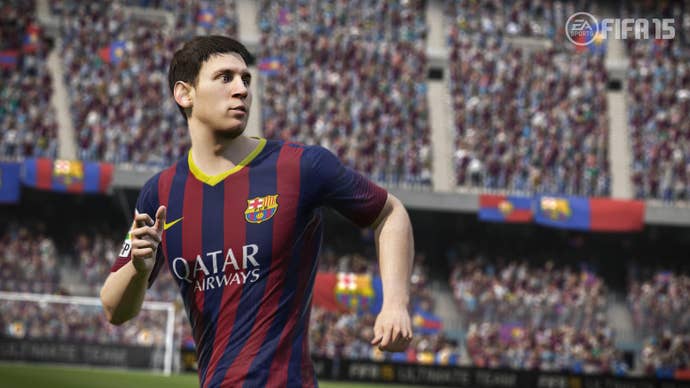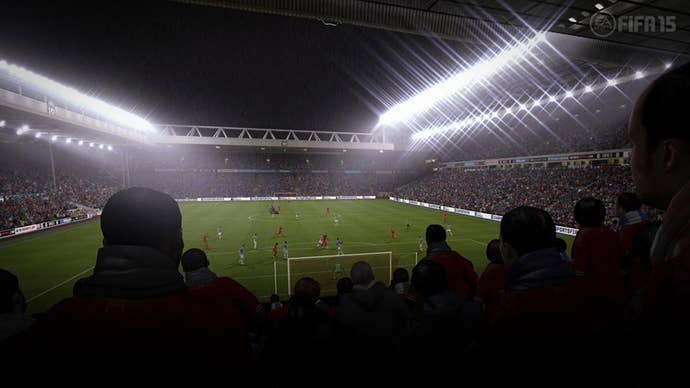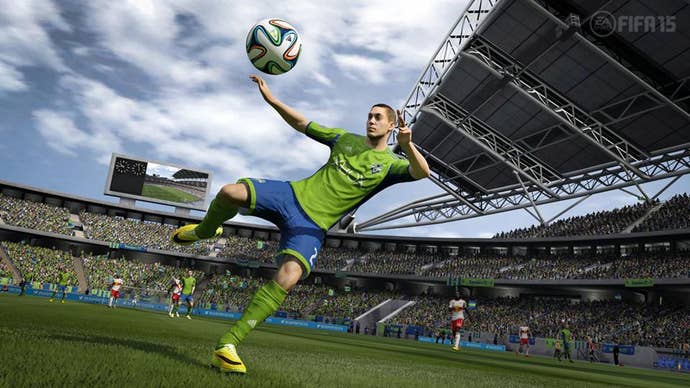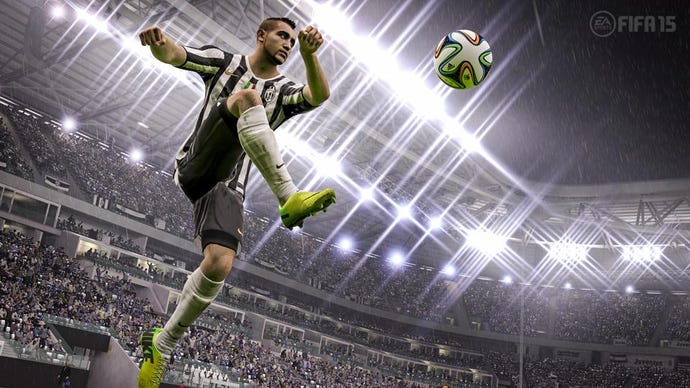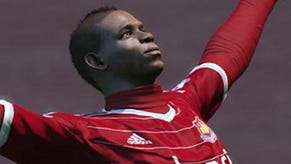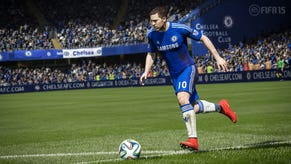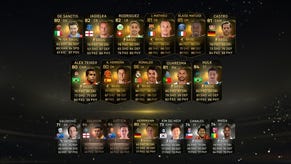FIFA 15: Ten game-changing features
The common complaint aimed at FIFA is that its annual release cycle prevents significant progress being made with each new edition. Having already built FIFA 14 for next-gen hardware, however, developer EA Canada has the required experience to push the boundaries with FIFA 15.
From presentation and animation enhancements to increased AI realism, FIFA 15 is setting out to provide a wide variety of game-changing elements and upgrades. Based on a few hours spent playing a build of the game said to be '50 percent complete', here are ten of the most interesting alterations...
Feeling the emotion
FIFA 15's main objective is to present the game in a way that feels as close as possible to what you can expect when watching football on TV. To recreate that sensation, each player now has his own system of emotions - influencing their on-pitch reactions, expressions and relationships.
For example, a feisty midfield battle between two opponents will cause them to become visibly aggravated; they'll point the finger, angrily converse and push and shove each other whenever in close quarters.
Teammates react in a similar way. After an early goalkeeping error a defender may well offer condolences and encouragement to his number one, but further mishaps from the same player will lead to criticism from his own team. Supposedly, there are 600 different reactions that can potentially play out over the course of a single game.
These emotions are purely visual, they do not affect the gameplay at all. A criticised player will perform no differently than a praised one. Despite that, seeing Steven Gerrard give Daniel Sturridge a telling off for missing too many shots does add a genuine touch of personality to the action.
Context-sensitive team AI
CPU-controlled opponents now take the context of the match into account when defining their tactical approach. For example, if there are only a few minutes remaining in a cup final, and your opponent is a goal up, then you can expect them to sit back and defend with 11 men behind the ball. Switch the situation around, with you winning, and they will throw everything at you.
This same idea applies from the opening kickoff of certain matches, too. You might be involved in a two-legged match, with the first leg ending 3-0 to the CPU. In this situation you can be fairly safe in predicting that they're going to 'park the bus' and defend their lead. It's up to you to work out how to beat such tactics.
Improved tackling
Tackle success rate is being raised, bringing it more in line with the real-life game. According to EA Canada, FIFA 14's tackle success rate averaged out at roughly 50 percent, whereas in FIFA 15 it's currently sitting at between 70 and 80 percent - although that balance may be tweaked before release day.
Clearly, the goal here is to no longer favour attacking players in one-on-one encounters - the world's best defenders now finally able to hold their ground against elite dribblers such as Arjen Robben and Lionel Messi. It should also give players that prefer defensive tactics more freedom to lock the down pitch in an effort to keep clean sheets.
Smarter players
Don't think that improvements to tackling results in fewer scoring chances. In the line with the changes to a team's overall AI approach, individual players are being tweaked to allow them to more intelligently find space and time their runs to match the flow of play.
Therefore, while it's more difficult to take on an entire team's defence by yourself, passing your way through the lines is more a valid option than ever. Such improvements apply to each of the game's players, not just the attackers; helping you pass the ball out of defence during potentially dangerous moments, or allowing you to opt for a calmer, slower possession-based game.
If you enjoy men with muscles...
...then you'll be happy that player models are noticeably improved over last year's effort. Gone are the shapeless, bulky bodies of FIFA 14, replaced by leaner, meaner variations that actually make the digital footballers look like the professional sportsmen they are.
Particular attention has been paid to the chest and shoulders, with heavily-toned players such as Sergio Ramos, Cristiano Ronaldo and Zlatan Ibrahimovic boasting all the relevant lines and bulges under their shirt. It all adds to FIFA 15's determination to vastly improve its visual realism and mimic what we expect to see from a TV broadcast.
On to crowds, animation, physics and the pitch itself...
The individuality of crowds
While next-gen editions of FIFA 14 brought with them upgrades to the quality of crowd animations, the changes lacked diversity and individuality; any given team's fans simply a copy-and-pasted edition of the next, with only their shirts altered to match club colours. After only a handful of matches, the effect was one of visual monotony.
FIFA 15's crowds exhibit unique actions that more accurately match the teams on the pitch. For example, the Argentinean fans of Boca Juniors jump and shout like merry madmen in celebration of a goal, the whole stadium looking as though it's going to crumble from the vibrations. Man City's fans, on the other hand, are more than ready to engage in their recently-adopted 'Poznan' victory dance after an important win.
Gameplay-changing animations
A range of new animations have been added, some affecting gameplay and others purely aesthetic. An example of the latter includes hair movements, so you can now see the long, flowing locks of Falcao move as he runs, while David Luiz's ungainly mop bobs and beats up and down as he jumps for headers and shoves his way past opponents.
More meaningful are changes to how player's use their feet. Predominantly left-footed players, for instance (think Robben and Bale), are now very unlikely to use their weaker side when dribbling. As a defender, therefore, you can try to force them into using their weaker foot through intelligent positioning of your body. In turn, this increases the chance of them making a mistake.
It's implementations like this that casual football followers are likely to struggle with, as knowing the preferences and playing styles of individual players is set to become more important than ever.
Visible wear and tear to the playing surface
If you're a FIFA veteran then you'll be well aware of the fact that the state of the pitch has always remained constant throughout a match, forever resembling a pristine carpet of vibrant green. Dull, wet green in rain-soaked games.
All change in FIFA 15: every slide, slice and footprint visibly impacts the appearance of the turf. I've experienced it for myself and the playing surface really is unrecognisable at the end of a game. The effect is exclusively visual, however, meaning that the ball doesn't bounce any differently whether it hits a patch of grass or a muddy divot.
The reason for the lack of gameplay impact is that FIFA's camera angles are unable to provide you with a close enough view of the ground for you to judge just how seriously the turf in any specific area has been chewed up. It would be unfair, therefore, for such a thing to influence play.
Turning on a dime
An improved 'locomotion' system means players can turn and spin in much tighter circles thanks to changes to the way physics influence their 'skeletons', making limb movement more realistic. Depending on the player in question's respective speed and agility attributes, this means it's slightly easier to retain possession of the ball in tight spaces as you now have the ability to move with greater dexterity. In FIFA's past, keeping possession in such a situation largely came down to pressing the 'shield ball' button.
Such improvements are balanced out by the aforementioned changes to tackle success rates, though. Expect individual struggles for the ball along touchlines and goallines to feature more prominently.
Dynamic ball physics
The spin of the ball is now directly influenced by exactly where the player's foot touches it and how much power is applied, meaning shots and passes performed when off balance can lead to unpredictable movement through the air. Most interestingly, though, it means it's now much easier to redirect the ball and retain its original speed and spin.
During corners and free kicks is when the change is most noticeable, tall strikers and defenders able to head the ball towards goal/safety by simply getting a touch and altering the velocity applied by the set-piece taker. The same concept can be applied to passes along the floor, letting you perform quick little flicks and cushions and keep the tempo high in the fashion of Barcelona and Brazil.
FIFA 15 will release later this year.
